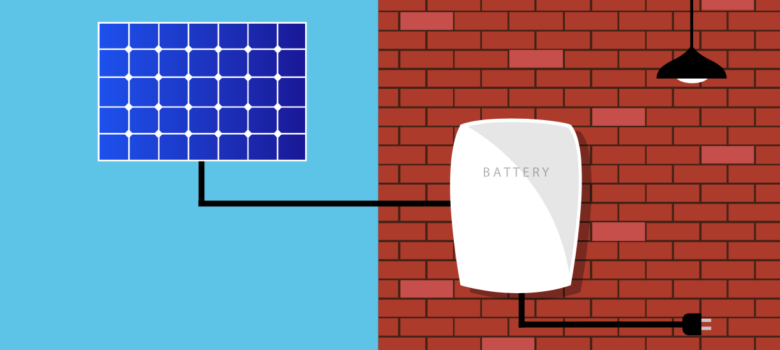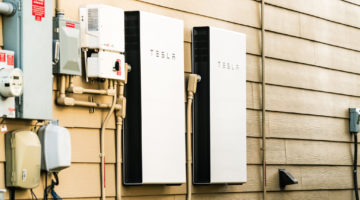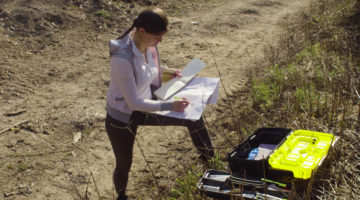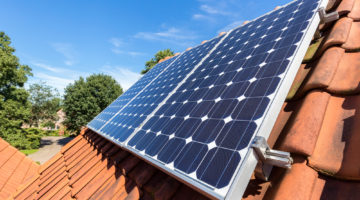
UPDATE: The Feed-In Tariff is now closed for new applications. To find out about the new scheme designed to replace it, click here.
Battery storage – the key to using your own electricity 24/7
We’ve been writing about solar PV since it was a fairly new technology. While many early adopters were passionate about getting involved with this innovative and exciting technology, they did so with an amount of uncertainty.
It now seems these people were right to take a giant leap of faith. The promise of free electricity was fulfilled, their panels did not all blow off the roof in a storm and those in the south of England demonstrably benefited from their geographical location, just like the salesman said! Taking advantage of the Feed-in Tariff, a huge number of people made an absolute killing from their solar system. But even though 600,000 households have installed solar on their homes, there has always been one thing missing with solar energy – the ability to use your own solar generated electricity 24 hours per day.
The exciting news is that this is no longer the pipe dream it once was. Enter home battery storage!
Home solar battery storage
Solar panels on roofs are no longer a novelty; those who dismissed solar as a gimmick are now seeing it come of age, thanks to new battery storage technology. It’s now all about maximising the benefits for those who have invested in solar.
Most of the 600,000 people who have installed solar panels on their properties have installed grid tied solar systems. A grid tied solar system allows you to feed the electricity produced by the solar panels back to the grid if you are creating an excess (i.e your electrical appliances at home are using less electricity that is being generated from the panels). The other major benefit from a grid tied system is that when the sun doesn’t shine you can draw electricity from the grid.
If you quickly consider the cost of electricity (about 12.5p / kWh to buy), it makes sense to try and use as much of the free electricity you are producing as possible instead of sending it back to the grid. Battery storage systems make this all possible. Instead of sending the excess electricity back to the grid, you store it in a battery that can then discharge and power your appliances when the sun isn’t shinning.
So with all this in mind – where do you start when looking to install a battery storage system?
Picking the right battery for your battery storage system
You have 3 choices at the moment when you are considering buying a solar battery storage system for your home.
- Lead acid batteries
- Lithium ion batteries
- Flow batteries
Lead Acid Batteries
This type of battery has been used for decades as part of renewable energy storage systems, normally when people have tried to make the transition to living off grid. They are the cheapest type of battery on the market at the minute (although Tesla are trying to change that!), however they are limited on the number of charging cycles they can handle before they need replacing. Also lead acid batteries often require more maintenance then either lithium or flow batteries.
Lithium Ion Batteries
Lithium ion batteries are the current favourites used by many battery manufacturers including the Tesla Powerwall and Powervault (although Powervault also make a lead acid battery). These batteries are marginally more expensive than Lead acid batteries but can be charged and discharged far more meaning they last longer. Lithium Ion batteries also tend to take up far less space than lead acid batteries and they are also self contained so they can sit easily indoors on a wall or out of the way – basically they are maintenance free!
Flow Batteries
These are the new kid on the block and could well be the future due to the fact that they can be charged and discharged theoretically an infinite number of times. There are two issues with Flow batteries – firstly they are expensive, about twice the price of the Lithium Ion batteries. Secondly they are very complex, often requiring ancillary equipment such as pumps, sensors, control units and secondary containment vessels. This obviously adds to the cost, but also means they generally take up a big amount of space.

Get yourself a solar battery management system
Obviously, the batteries are the most important component when you are looking to store all that electricity you have created from your solar PV system; but a major feature for the efficient use of this electricity is a battery management system. All battery systems nowadays will come with a BMS.
A battery management system (BMS) keeps a check on the key operational parameters during charging and discharging such as voltages and currents and the battery internal and ambient temperature. The BMS also helps to make the right decisions as to what to do with this valuable free electricity your solar system is producing. Almost certainly, your weekday usage will be different to that at weekendsv – the BMS manages all this for you!
A fully charged storage system will easily supply a family’s lights and background usage once the sun goes down. Sure – if you need to run a particularly power-hungry appliance, it may require more input than is supplied by your battery system. But the solar power will at least subsidise the electricity you import from the Grid. Any free energy is worth having!
What solar battery storage systems are available?
Products have flooded the market in recent years, offering consumers a more viable way to use the solar energy they have harnessed. There are a huge number of companies jumping on the home battery storage bandwagon, all offering different sizes of system. Tesla is one of the best known. Their product is known as the Powerwall; it is a modular 7kWh system, which means you can link lots of the units together.
We will look at this- and some other offerings– in more detail over the coming months.
What should I bear in mind when buying a battery storage system?
A battery management system should be tailored to your energy usage!
It makes sense that the bigger the battery, the more electricity you can store. But it goes without saying that the bigger the battery you choose, the more you will pay for the system. By the same token, there is no point buying a massive storage system if your solar panels will never fully charge it. In the near future there may be a case for charging your battery from the mains grid – if Time of Use tariffs come in to play but a decent BMS should help you optimise the electricity you produce from the solar systems.
It is important that the battery management system is programmed to suit your requirements for power.
It’s worth speaking to an expert, who can ask you a few simple questions about how you live and work. A bit of planning is always necessary, as you don’t want to wake up in the morning with the sun peering through your bedroom window and your storage battery still half charged. Make sure you use it!
There are limits to how much solar electricity you can store.
Do remember that although battery systems allow you to store solar electricity produced, it is still pretty unrealistic to live completely off grid. You would need a massive battery system and a massive solar array to charge it (10kWh +).
Does battery storage affect the Feed-in Tariff?
UPDATE: The Feed-In Tariff is now closed for new applications. To find out about the new scheme designed to replace it, click here.
The installation of this equipment and utilisation of the power you have generated in no way affects your income from the Feed-in Tariff. This is because, if you recall, the lower tariff you get paid for the 50% exported power was only an estimate by the government and is unmetered – you are fully entitled to use as much power as you like.
Installing Solar PV or Battery Storage?
Interested in having a battery storage system, or solar PV installed in your home? We have scoured the country for the best tradesmen, so that we can make sure we only recommend those we really trust.
If you would like us to find you a local installer to help install a new system in your home, just fill in the form below and we will be in touch shortly!













To maximiSe my solar pv without an expensive battery is there a way to trigger my appliances automatically when there is adequate solar energy ?
Hi Peter, have a look at solar Optimisers to do this – they measure the homes electricity usage and how much electricity is being produced by the solar system. When there is an excess of electricity being produced, this would normally be exported back to the grid, but the solar optimiser redirects this electricity to a storage system e.g. the immersion element on the hot water tank, a storage heater or a battery.
Hi how does a battery storage system fit to an existing solar system please
Hello Peter…Use more of the electricity generated through PV systems by installing one of the many battery storage solutions currently available.
I like the idea of storing the excess power my panels generate.
2 problems (cost aside as everything power related seems to be expensive)
One – I’ve already got an I-boost – so free hot water when there is an excess – not going to be much left after that?
Second – the batteries I’ve seen have all been the size of washing machines – where to find the space!
Hi Graham, you are right – if you already have a solar diverter, then this is probably not going to be worth it for you. The batteries are pretty big unfortunately, so you are going to need a garage or somewhere like that to mount them. I have seen the Tesla Powerwall and to be honest it is not that big, so hopefully if you do decide to go down the solar PV / battery route then you will be able to find a suitable place to mount it!
Thanks incredibly useful blog about solar PV and the associated battery systems. My situation is a bit more complex. So we have currently a 3kWp solar PV system on our roof, and this summer we are building a two-store side return and a front portion which will increase the total available roof size for more solar PV panels. Potentially I think in total we will be able to have 5.5kwp. I am still unsure as to which battery system to go for to retrofit the whole thing. Do I go for Tesla, Victron, LG or Mercedes.
Hi Len, this depends a little bit how you are using the electricity? Are you at home during the day (so just want to use the battery for better energy management) or are you looking to store decent amounts of power to use when the sun isn’t shining? Remember if you are going to install more solar panels to get this done by an MCS approved installer – this will mean that you can still benefit from the Governments FIT (even though they are now relatively low). Let me know on the first point and I will come back to you with my thoughts (and hopefully others will too!!)
Just read your blog and I feel that I may be the first of many to be asking this Question .If I get an existing Litham -ion I have looked at powervault but found the expense hard to warrant due to the fact my Electricity bill is approx about £15-20/mth the bulk of that cost being the standing charge but now being able to export the battery store power back to the grid I’m just wondering what extra work would be needed to allow this to happen or Do you wait a bit longer until such systems are available
Hi Charlie, personally I think the announcement from the Government yesterday will pave the way for larger capacity batteries being installed in the home (larger than our currently available) since the bigger the battery, the more energy that can be stored and the more potentially can be made from exporting it back. The process of sending electricity back to the grid is pretty simple though, so a battery bought today should facilitate this.
What is going to be interesting is seeing how the grid cope with all this micro generators now being able to feed back into the grid!!
This is a very useful article, espically in light of the Governments recent announcements. Have you any thoughts on electric cars to grid (V2G) I am very interested in the possibilities of this espically with the Government announcing they won’t sell petrol / diesel cars by 2040. That means everyone may have a battery in their home (in their car). I am very excited about this move and with Tesla launching their Model 3 today I think the future is very bright and we could well be about to enter a Green Age!!
Hi Seb, we are really excited by the potential of V2G. Nissan recently carried out a test of 100 of their Nissan Leaf electric vehicle models giving owners will have the flexibility and power to sell stored energy from their vehicle battery back to the National Grid. The test proved very successful and we think it is only a matter of time before this becomes the norm.
I think the real challenge though will be managing the grid with batteries and solar PV becoming a bigger part of it. I think rather than the household forcing the grid to accept the electricity (from the battery), it will be set up more that the homeowner has made the electricity available and the grid will decide whether to buy it or not depending on demand so the grid would have the ability to draw power from the battery remotely should the household make it available to them.